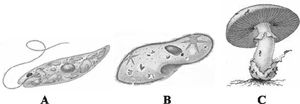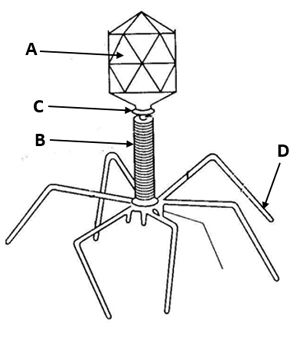Identify the following figures A, B and C.

A – Euglena, B – Paramecium, C – Agaricus
A – Euglena, B – Planaria, C – Agaricus
A – Planaria, B – Paramecium, C – Agaricus
A – Euglena, B – Paramecium, C – Aspergillus
Correct Answer :
A. A – Euglena, B – Paramecium, C – Agaricus
Euglenoids includes Euglena like flagellates which have plant like characteristics (chlorophyll) in addition to some animal characteristics. Paramoecium is a ciliated protozoan, aquatic and actively moving organisms because of the presence of thousands of cilia. Agaricus (mushroom) belongs to class basidiomycetes of kingdom Fungi.
Related Questions
Match column-I (Characters/feature) with column-II (examples) and choose the correct option.
| Column-I | Column-II |
|---|---|
| (Characters/features) | (Examples) |
| A. Red dinoflagellates | I. Rhizopus |
| B. Unicellular fungi used to | II. Gonyaulax make bread and beer |
| C. Source of antibiotics | III. Yeast |
| D. Bread mould | IV. Penicillium |
A III; B II; C I; D IV
A II; B III; C I; D IV
A II; B III; C IV; D I
A II; B IV; C III; D I
Identify the following figures A, B and C.

A – Euglena, B – Paramecium, C – Agaricus
A – Euglena, B – Planaria, C – Agaricus
A – Planaria, B – Paramecium, C – Agaricus
A – Euglena, B – Paramecium, C – Aspergillus
A specimen of fungus is brought by a student for identification. Upon close examination, he discovered that its hyphae are completely septate and it has gills on the underside of the pileus. To which fungal group does it most likely belong ?
Basidiomycetes
Zygomycetes
Ascomycetes
Chytrids
The bacteria which oxidize various inorganic substances and use the released energy for their ATP production are called _______________.
Archaebacteria
Heterotrophic bacteria
Photosynthetic autotrophic bacteria
Chemosynthetic autotrophic bacteria
Match the terms given in column-I with their examples given in column-II and choose the correct option
| Column-I | Column-II |
|---|---|
| (Terms) | (Examples) |
| A. Ascus | I. Spirulina |
| B. Basidium | II. Penicillium |
| C. Protista | III. Agaricus |
| D. Cyanobacteria | IV. Euglena |
| E. Animalia | V. Sponges |
A II, B III, C IV, D V, E I
A I, B II, C III, D V, E IV
A II, B V, C III, D I, E IV
A II, B III, C IV, D I, E V
Match the class of fungi given in column I with their examples given in column II and choose the correct option
| Column-I | Column-II |
|---|---|
| (Class of fungi) | (Examples) |
| A. Ascomycetes | I. Rhizopus |
| B. Basidiomycetes | II. Penicillium |
| C. Deuteromycetes | III. Ustilago |
| D. Phycomycetes | IV. Alternaria |
A IV, B III, C I, D II
A II, B III, C IV, D I
A IV, B I, C II, D III
A III, B IV, C II, D I
Match column I (Kingdom) with column II (Class) and select the correct options
| Column-I | Column-II |
|---|---|
| (Kingdom) | (Class) |
| A. Plantae | I. Archaebacteria |
| B. Fungi | II. Euglenoids |
| C. Protista | III. Phycomycetes |
| D. Monera | IV. Algae |
A IV, B III, C II, D I
A I, B II, C III, D IV
A III, B IV, C II, D I
A IV, B II, C III, D I
Match the class of fungi given in column-I with their common name given in column-II and select the correct option.
| Column-I | Column-II |
|---|---|
| (Class of fungi) | (Common name) |
| A. Phycomycetes | I. Sac fungi |
| B. Ascomycetes | II. Algal fungi |
| C. Basidiomycetes | III. Fungi imperfecti |
| D. Deuteromycetes | IV. Club fungi |
A II, B I, C IV, D III
A II, B IV, C I, D III
A IV, B I, C II, D III
A IV, B III, C II, D I
Select the correct match from the given option.
Occurrence of dikaryotic stage - ascomycetes and basidiomycetes.
Saprophytes - They are autotrophic and absorb soluble organic matter from dead substrates.
Vegetative mean of reproduction in fungi - fragmentation, budding and sporangiophores.
Steps involved in asexual cycle of fungi - plasmogamy, karyogamy and meiosis in zygote resulting in haploid spores.
Match the scientists given in column I with their discovery given in column II and choose the correct option.
| Column-I | Column-II |
|---|---|
| (Scientists) | (Discovery) |
| A. Ernst Mayr | I. Discovered Viroids |
| B. Whittaker | II. Gave the name virus |
| C. Pasteur | III. Proposed five kingdom classification |
| D. Diener | IV. Darwin of the 20th century |
A IV, B III, C II, D I
A III, B IV, C II, D I
A II, B III, C IV, D I
A I, B II, C III, D IV
Protozons are not included in kingdom animalia because they are
mostly asymmetrical.
unicellular eukaryotes.
heterotrophic in nature.
multicellular prokaryotes.
The subunit of capsid is called
core
nucleotide
amino acid
capsomere
Choose the correct statements (i v) regarding mycoplasma
(i) Mycoplasma has no cell wall.
(ii) Mycoplasma is the smallest living organism.
(iii) Mycoplasma cannot survive without O2.
(iv) Mycoplasma are pathogenic in animals and plants.
(v) A sort of sexual reproduction occurs in bacterium by adopting a primitive DNA transfer from one bacterium to the other.
Only (iii)
(i), (iii) and (v)
(i), (ii), (iv), and (v)
All of the above
Which of the following is not a viral disease ?
AIDS and mumps
Small pox and herpes
Influenza
Cholera
Which of the following groups of protozoan is not correctly matched with its feature?
Amoeboid - Marine forms have silica shells on their surface.
Flagellated - Either free living or parasitic.
Ciliated - Actively moving organisms due to presence of cilia.
Sporozoans - Move and capture their prey with the help of false feet.
The figure given below shows the structure of a bacteriophage. Identify its parts labelled as A, B, C and D.

A - Tail fibres B - Head C - Sheath D - Collar
A - Sheath B - Collar C - Head D - Tail fibres
A - Head B - Sheath C - Collar D - Tail fibres
A - Collar B - Tail fibres C - Head D - Sheath
Which of the following is/are example(s) of deuteromycetes?
Alternaria
Colletotrichum
Trichoderma
All of these
Assume that two normal hyphal cells of different fungal mating types unite. After a period of time, the cell between these cells will dissolve producing a
mycelium
fruiting body
zygote
dikaryotic cell, which is also heterokaryotic
The given figure shows some labelled structure as A, B, C and D. In which structure the protein coat that encloses the nucleic acid is present?

A
B
C sheath
D tail fibres
The most abundant prokaryotes helpful to humans in making curd from milk and in production of antibiotics are the ones categorised as
cyanobacteria
archaebacteria
chemosynthetic autotrophs
heterotrophic bacteria
The given characters are seen in which of the following group?
(i) Unicellular, colonial, filamentous, marine or terrestrial forms.
(ii) The colonies are surrounded by a gelatinous sheath.
(iii) Some can fix atmospheric nitrogen in specialized cells called heterocysts.
(iv) They often form blooms in water bodies.
Archaebacteria
Cyanobacteria
Chrysophytes
Dinoflagellates
Which of the following statement(s) is/are correct ?
(i) Reproduction in fungi can take place by vegetative means fragmentation, fission and budding.
(ii) Fusion of two nuclei is called plasmogamy.
(iii) Fusion of protoplasms between two motile or nonmotile gametes is called karyogamy.
(iv) Meiosis in zygote results in diploid spores.
Only (i)
Both (ii) and (iii)
(ii), (iii) and (iv)
All of these
Which of the following statement is correct for both bluegreen algae and bacteria ?
Both show anaerobic respiration.
Both have chlorophyll pigment.
Both are devoid of true nucleus.
None of the above
Protista includes
unicellular eukaryotes with well-defined nucleus only.
unicellular prokaryotes with membrane bound organelles.
unicellular eukaryotes with well-defined nucleus and membrane bound organelles.
both unicellular and multicellular eukaryotes with welldefined nucleus and membrane bound organelles.
Which class of fungi lacks sex organs but the process of plasmogamy is brought about by fusion of two vegetative or somatic cells of different strains or genotypes?
Sac fungi
Bracket fungi
Imperfect fungi
Phycomycetes
Which of the following is the correct sequence of three steps in the sexual cycle of fungi?
Mitosis -> Meiosis -> Fertilization
Plasmogamy -> Karyogamy -> Meiosis
Mitosis -> Plasmogamy -> Karyogamy
Karyogamy -> Plasmogamy -> Meiosis
Fungi show asexual reproduction by all of the following kinds of spores except
conidia
oospores
sporangiospores
zoospores
Clamp connection is found in
basidiomycetes
ascomycetes
saccharomycetes
haplomycetes
A fungus contains cells with two nuclei from different genomes. The nuclei do not fuse but divide independently and simultaneously as new cells are formed. This fungus belongs to
phycomycetes
zygomycetes
deuteromycetes
basidiomycetes
Which of the following statement is incorrect ?
TMV has a double-stranded RNA molecule.
Most plant viruses are RNA viruses.
The bacteriophage has a double-stranded DNA molecule.
Most animal viruses are DNA viruses.
